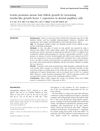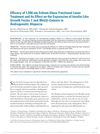Search
forLearn
5 / 7 resultslearn Procyanidin
bioflavonoid found in plants with antioxidant and hair stimulating properties
learn Minoxidil
An essential vasodilator with some anti-androgenic effects, has excellent safety record
learn Vascular Endothelial Growth Factor
learn sh-Polypeptide-7
Research
5 / 1000+ resultsresearch Induction of Hair Growth by Insulin-Like Growth Factor-1 in 1,763 MHz Radiofrequency-Irradiated Hair Follicle Cells
Radiofrequency exposure can stimulate hair growth by increasing IGF-1 in hair follicle cells.
research L-Ascorbic Acid 2-Phosphate Promotes Elongation of Hair Shafts via the Secretion of Insulin-Like Growth Factor-1 from Dermal Papilla Cells Through Phosphatidylinositol 3-Kinase
Vitamin C derivative helps hair grow longer by making cells produce a growth factor through a specific cellular pathway.
research The Effects of Rosemary Oil on Enzyme Activities and Cytokine Expression Related to Hair Growth in C57BL/6 Mice
Rosemary oil may promote hair growth by enhancing enzyme activities and IGF-1 expression.

research Icariin Promotes Mouse Hair Follicle Growth by Increasing Insulin-Like Growth Factor 1 Expression in Dermal Papillary Cells
Icariin helps mouse hair grow by boosting a growth factor in skin cells.

research Efficacy of 1,550-nm Erbium-Glass Fractional Laser Treatment and Its Effect on the Expression of Insulin-Like Growth Factor 1 and Wnt/β-Catenin in Androgenetic Alopecia
Laser treatment improves hair density and increases growth factors in androgenetic alopecia.
Community Join
5 / 85 results
community Compressed part of research of theory of androgenic/anabolitic balance. AGA h-responders analytic. Theory of physio-metabolitic method of anti AGA treatment
The treatment for androgenetic alopecia involves using finasteride and minoxidil with intense exercise and cold exposure to boost metabolism and reduce androgenic effects, potentially leading to hair regrowth. This approach may activate biological pathways for improved hair and overall health.
community UPDATE: The theory that explains everything. Please help me make this big!
Hair loss theory involves 3alpha-hydroxysteroid reductase (3AHD) converting DHT to androstenol. Discussion explores potential treatments and encourages more research.
community IGF-1 and Peptides? Miracle molecule waiting to be found
The conversation discusses potential hair loss treatments focusing on stimulating IGF-1 at the follicle level using growth-factor cocktails and engineered peptides, such as Acetyl Tetrapeptide-3, Copper Tripeptide-1, Oligopeptide-20, Thymosin-β4, and Palmitoyl Tetrapeptide-7. It suggests that device-assisted delivery methods like microneedling may enhance effectiveness.
community Is IGF-1 the reason why some people don't respond well to min-fin treatment?
A user who didn't respond well to minoxidil and finasteride is considering the role of IGF-1 in hair loss treatment effectiveness. They discuss the potential of using HGH to improve hair growth and other health issues, referencing several sources that suggest IGF-1 levels may influence hair loss and treatment response.
community My Theory Of Androgenic Alopecia
Hair loss is linked to cellular physiology and the IGF-1 to TGF-B1 ratio, not just androgen sensitivity. The theory lacks evidence, while finasteride and minoxidil are effective treatments.